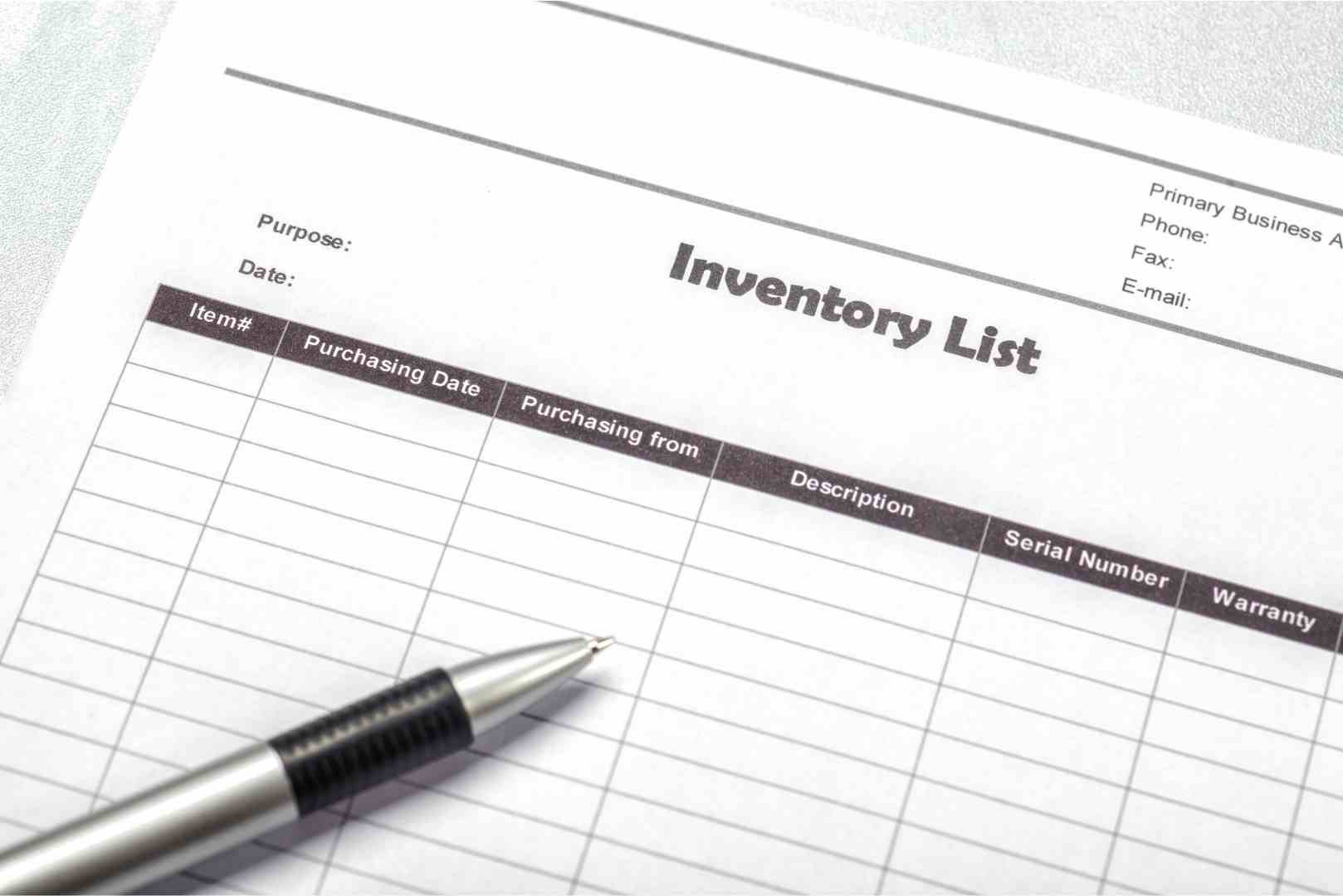A business inventory list is an account of exactly which products and supplies you have on hand, in an effort to keep your inventory as organized as possible. The need for accurate inventory lists stems from the fact that if you aren’t able to keep up with what items you have available, you’re likely to run into inventory issues (like overstocks, stockouts, and so on). But with ongoing, detailed documentation of your stock, you can coordinate a much smoother supply chain and optimize your inventory management strategy as a whole.
What is an inventory list?
An inventory list is a comprehensive, itemized list that details every product your company has in stock, including raw materials, work-in-progress items, and finished goods. In general, an inventory list should include the product’s name, SKU number, description, pricing, and quantity. With that said, these lists are dynamic, not static — meaning they can be updated or edited as needed. Inventory lists help brands to easily monitor their stock levels, allowing for greater inventory control and a more streamlined approach to inventory management.
3 reasons you need an inventory list

Organize your inventory
Let’s face it: your company will have a tough time fulfilling its orders if you don’t have a good grasp on what’s in stock at any point in time. Organized product inventory is the foundation for an efficient supply chain, accurate fulfillment, and a satisfied customer base; luckily, inventory lists keep close tabs on your product movement, so you know everything you have in stock and/or what’s ready for sale. This knowledge means you’ll never have to worry about missing out on potential profits, since you can capitalize on the inventory that’s readily available.
Track inventory performance
Inventory performance is a measure of how well your company’s inventory items are being used and replenished, as a means to compare actual dollars versus forecasted cost of goods sold. Among other relevant performance metrics, inventory lists look at your own inventory turnover ratio, revealing how many times your SKUs were sold and replaced within a specified period of time. Using an inventory list, therefore, can help you prevent dead stock items from collecting on your shelves (and protect you from a huge spike in inventory carrying costs).
Make data-driven decisions about inventory
On occasion, a business might release a product that isn’t nearly as popular with consumers as they’d expected (or projected) it to be. When this happens, there can be a large volume of unsold inventory sitting in that retailer’s warehouse, accumulating higher and higher storage costs as time goes on. The best way to avoid this type of overstock situation is to utilize an itemized inventory list. This will give you a complete rundown of which items are or aren’t selling, so you can make precise, data-driven decisions about your inventory.
In a time where interest rates have risen post-pandemic, this is particularly important for brands to have a process in place to guide their inventory strategy. Extensiv arms brands with critical sales insights across all channels on product trends and eliminates the chaos of manual inventory updates to spreadsheets so you don't have to fight this battle again. Quickly understand where in your product catalog you should be investing in while running sales and marketing promotions to efficiently offload dead stock before it does any further damage to your bottom line.
What to include in an inventory list?

Product name
Product names are used to distinguish the different goods and services your company sells. When you assign a name to something, what you’re really doing is anchoring that item in your customers’ minds and providing a bit more depth to your brand identity. In that way, a product naming strategy is the gateway to building solid brand recognition, one item at a time.
Product SKU number or ID
A stock keeping unit (SKU) number is a unique sequence of numbers and letters that represent individual products within a company’s inventory. Typically, a SKU’s information is listed in order from greatest to least importance. A product identifier (ID), then, is a series of numbers and letters that serves as the key to locating products online (i.e. on marketplaces like Amazon).
Product description
A product description is essentially the marketing copy that’s used to describe and define the benefits of your product. In short, the description provides all the particulars of your product as they appear on your website. While product details can come in bullet form or composed in a short paragraph, the best descriptions are clear, concise, and help drive conversion.
Price
A product’s price is the translation of its value into quantitative terms, and it’s what the customer can expect to pay for said item. Although product pricing is usually determined prior to releasing goods on the market, businesses do have the ability (and authority) to change the selling price at any point — which may occur in response to fluctuations in supply and demand.
Quantity in stock
Quantity in stock is the total number of an item you currently have available for use or resale purposes. In other words, it’s your total stock on hand, less any products that have been allocated elsewhere. Understanding these quantities ensures you don’t encounter an overstock or understock situation (both of which can be detrimental to your bottom line).
Reorder point
A reorder point (ROP) is the minimum amount of stock for an individual product that when reached, will trigger the reordering of more inventory. By calculating an accurate reorder point for each of the SKUs in your product catalog, you can be sure you always have enough inventory to meet customer demand without having surplus capital tied up in your stock.
Supplier and product information
Supplier information encompasses all the agreements made with suppliers (or other vendors), as well as the records of past and current purchases from said companies. A supplier may also have access to valuable product information you’ll want to obtain, as this can help in promoting and selling your products through your preferred channels or online marketplaces.
Important notes
Important notes are those specifics that offer special context for your products — things like a warranty, purchase date, or expiration date for food inventory. Whatever details or insights that may be pertinent to the product’s life cycle (or that give additional clarity about the item’s origin) can be incorporated into a separate ‘notes’ section of your inventory list.
How to create inventory lists in 3 ways (Pros & Cons)

Manual inventory list templates
A manual inventory list is fairly simple in its construction and execution. In fact, you can even call on the help of a pre-made, printable inventory template to assist in this process. An inventory checklist template should include all the basic information discussed above (i.e. product name, SKU number, etc.). The advantage of a master inventory template is that you can use a free download and then copy and paste this design over and over again, without having to generate a new version for every product. But on the flip side, a major drawback to this method is having to manually update all your product info, which can be a very time-consuming task.
Excel inventory lists
An Excel inventory management template comes in the form of a spreadsheet to manage your products. Similar to the previous template, an inventory spreadsheet also requires you to manually input all your product information and identifiers. Microsoft Excel can be a useful tool for some companies — like small businesses or startups — as it’s rather straightforward and has a short learning curve for new users. However, for anyone looking to scale their business and expand to the next level, these worksheets can prove pretty limiting. Not to mention, inventory sheets unfortunately open up for a greater chance of errors and inaccurate reporting.
Use an inventory management tool
Inventory management tools make a range of operations much simpler and more efficient, and inventory lists are certainly no exception. With the help of management tools and applicable integrations, you can oversee (and edit) your inventory levels with ease. For instance, companies can use barcode scanners or RFID technology to benefit from real-time, up-to-date inventory tracking — which then largely informs your inventory lists, as well. While these tools may take more time to implement than an Excel spreadsheet would, there’s no doubt they’ll enhance your workflows and spur on your company’s growth in the long run.
4 reasons to automate your inventory lists with Extensiv Order Management
Bring more transparency to your inventory data
Brands who automate their inventory lists with Extensiv order management can monitor all the inventory data from their sales channels and warehouses within one convenient dashboard. And the impact of this transparency is wide-reaching since you’ll know exactly what’s happening with your SKUs at any given time. In addition, housing your data in one unified place (instead of dispersing it among multiple spreadsheets) allows you to instantly compile whatever lists you need. Simply put, the more visibility you have in your data, the more organized and effective you’ll be.
Minimize human error
A lot of times when using manual processes, your inventory calculations become susceptible to human error — and the more errors you incur, the greater the toll on your profits. The ideal way to minimize these mistakes and reduce the effect they have on your revenue is to automate as many systems as you can (ultimately benefitting your inventory lists). Extensiv order management's inventory system has tons of features to help your brand perform its best, from automatic replenishment recommendations to automating your data flow across orders, inventory, and purchasing.
Optimize your inventory management process
Not only are manual processes more likely to be error-prone, but they require a great deal of time and effort from you, too. Think about how long it would take to create a single inventory list if you’re managing that product’s information by hand; it’s a daunting task, to be sure. But that’s where Extensiv order management’s automation comes into play again, as a way to optimize your entire inventory management process. By partnering with Extensiv, your company can automatically issue purchase orders and even establish inventory allocation rules to prevent overselling.
Gain inventory insights to drive growth decisions
Extensiv knows a thing or two about helping businesses grow and succeed within their industry. Take Specialist ID, for example. Fifteen years into business, this brand had reached a brick wall; they were passing over $5 million in gross sales, but still operating like they had when they were pulling in only $100,000 a year. That is, until they teamed up with Extensiv, and gained tremendous inventory insights thanks to automated demand forecasting, reorder points, and more. Specialist ID was able to upgrade their selling and beat their order ceiling, and has since gone on to double in size without any growing pains or limitations getting in their way.



![3 Ways To Create Inventory Lists [+Examples]](https://20995814.fs1.hubspotusercontent-na1.net/hub/20995814/hubfs/Skubana/Blog%20Pages/Imported_Blog_Media/Female%20entrepreneur%20holding%20a%20clipboard%20with%20inventory%20list-4.jpg?upsize=true&upscale=true&width=1200&height=800&name=Female%20entrepreneur%20holding%20a%20clipboard%20with%20inventory%20list-4.jpg)





